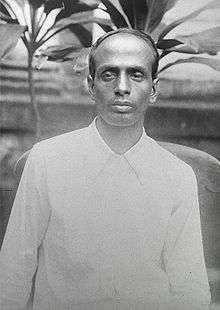Surya Sen
| Master da Surya Sen | |
|---|---|
 Sen | |
| Native name | সূর্য সেন |
| Born |
Surya kumar Sen 22 March 1894 Chittagong, Bengal Presidency, British India (now Bangladesh) |
| Died |
12 January 1934 (aged 39) Chittagong, Bengal Presidency, British India |
| Nationality | British Indian |
| Organization | Indian National Congress Anushilan Samiti |
| Known for | Chittagong armoury raid |
| Movement | Indian Independence movement |
Surya Sen (22 March 1894 – 12 January 1934) was a Bengali Indian independence activist who was influential in the Indian independence movement (against British rule) who is noted for leading the 1930 Chittagong armoury raid In Chittagong of Bengal in British India (now in Bangladesh). Sen was a school teacher by profession and was popularly called as Master Da ("da" is a honorific suffix in Bengali language). He was influenced by the nationalist ideals in 1916 while he was a student of B.A. in Behrampore College.[1] In 1918 he was selected as president of Indian National Congress, Chittagong branch.. This man was known for his brilliant actions and effort in Indian history by taking young teenagaers and turning them into revolutionaries against the British stationed in Chittagong with this bold step of recuriting in teenagers then fought against the British Cantonment and in the mountainous regions of Chittagong like Jalalabad hills, but then separated and went their separate ways still trying to get the British out of Chittagong, various attempts were successful in the beginning
but many failed as well and many revolutionaries were arrested which broke movement.
Early life
Sen was born on 22 March 1894[2] at Noapara, under Raozan upazilla in Chittagong. His father Ramaniranjan Sen was a teacher. In 1916 when he was a B.A. student in Berhampore College he learned about Indian freedom movement from one of his teachers. He felt attracted towards revolutionary ideals and joined a revolutionary organization Anushilan Samity. After completing his studies he returned to Chittagong in 1918 and joined as a teacher at National school, Nandankanan . At that time, Indian National Congress was the most prominent political party there.
Chittagong armoury raid
Sen led a group of revolutionaries on 18 April 1930 to raid the armoury of police and auxiliary forces from the Chittagong armoury.[3] The plan was elaborate and included seizing of arms from the armoury as well as destruction of communication system of the city (including telephone, telegraph and railway), thereby isolating Chittagong from the rest of British India.[3] However, although the group could loot the arms, they failed to get the ammunition. They hoisted the Indian National Flag on the premises of the armoury, and then escaped. A few days later, a large fraction of the revolutionary group was cornered in the nearby Jalalabad hills by the British troops. In the ensuing fight, twelve revolutionaries died, many were arrested, while some managed to flee, including Sen.[3]
Arrest and death


Sen stayed in hiding, and kept moving from one place to another. Sometimes he took up a job as a workman, a farmer, a priest, a house worker or even as a pious Muslim. This is how he avoided being captured by the British. He once hid in the house of a man called Netra Sen. But Netra Sen informed the British of his hiding, and the police came and captured him on February 1933. Before Netra Sen could be rewarded by the British, a revolutionary came into his house and beheaded him with da (a long knife). As Netra Sen's wife was a big supporter of Surya Sen, she never disclosed the name of the revolutionary who killed Netra Sen. Before Sen was hanged, he was brutally tortured by the British. The British executioners broke all his teeth with a hammer, and pulled out all his nails. They broke all his limbs and joints. He was dragged to the rope unconscious.
His last letter was written to his friends and said: "Death is knocking at my door. My mind is flying away towards eternity ...At such a pleasant, at such a grave, at such a solemn moment, what shall I leave behind you? Only one thing, that is my dream, a golden dream-the dream of Free India.... Never forget the 18th of April,1930, the day of the eastern Rebellion in Chittagong... Write in red letters in the core of your hearts the names of the patriots who have sacrificed their lives at the altar of India’s freedom." Sen was given a burial at sea in the Bay of Bengal.[4]
In popular media
Indian film director Ashutosh Gowariker directed the film Khelein Hum Jee Jaan Sey (2010) about Sen's life. Actor Abhishek Bachchan played the role of Sen.[5] Another film Chittagong (2012) directed by Bedabrata Pain was about Sen's armoury raid. Manoj Bajpayee played the leading role.[6]
See also
References
- ↑ Islam, Asiatic Society of Bangladesh. Chief ed. Sirajul (2003). Surya Sen (1. publ. ed.). Dhaka: Asiatic Society of Bangladesh. ISBN 9843205766. Retrieved 28 June 2015.
- ↑ Mrinal Sen (1 January 2002). Montage: Life, Politics, Cinema. Seagull Books. p. 7. Retrieved 17 December 2012.
- 1 2 3 Chandra, Bipan (1 June 1989). India's Struggle for Independence: 1857-1947. Penguin Books India. pp. 251–252. ISBN 978-0-14-010781-4.
- ↑ "Surya Sen,Early life,Chittagong armoury raid and its aftermath,Memorials". Towards Freedom. Retrieved 2015-06-28.
- ↑ "Ashutosh Gowariker's Khelein Hum Jee Jaan Sey to be released on December 3.". Daily News & Analysis. 22 April 2010. Retrieved 11 October 2011.
- ↑ "'Chittagong': Manoj Bajpayee took no money for the film". The Times of India. 28 September 2012. Retrieved 28 September 2012.
